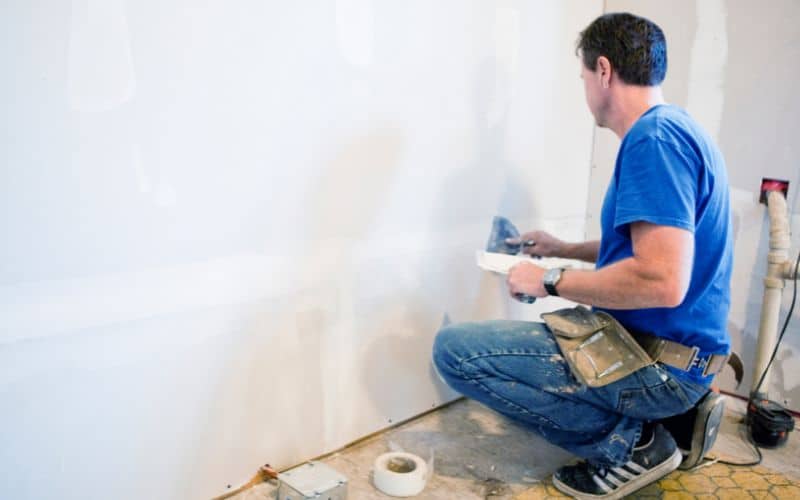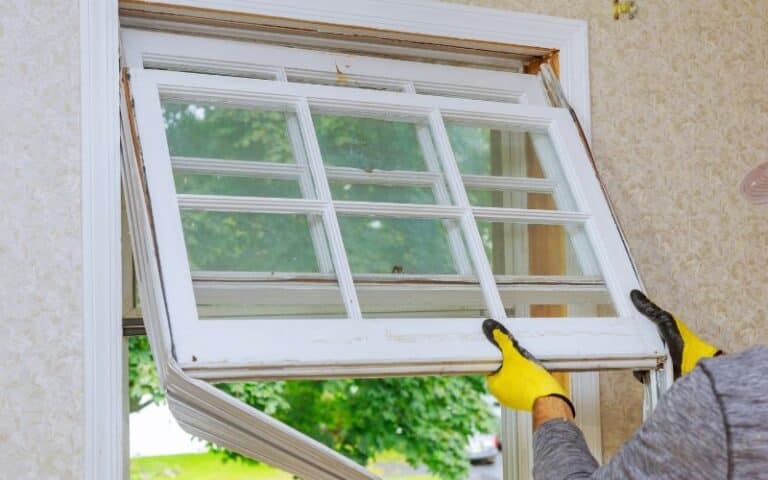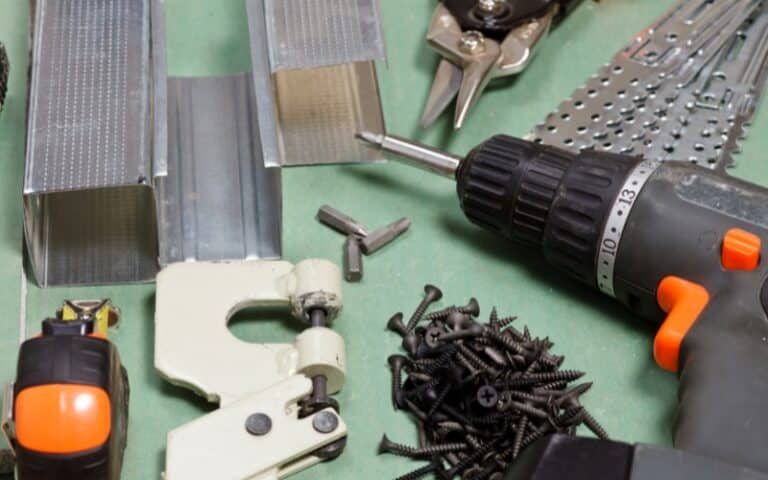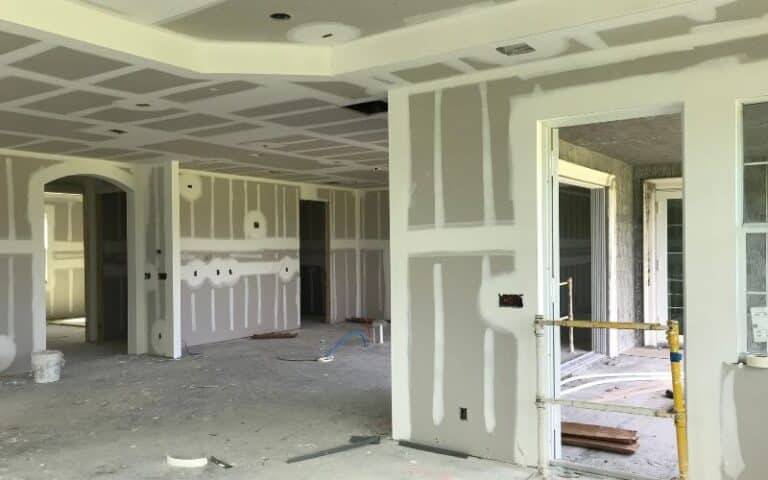Drywall mud is vital for attaining smooth and seamless surfaces in home remodeling or renovation projects.
But what if you find that the drywall mud you were going to use is contaminated with mold?
Concerns about the usefulness and potential health issues arise when mold is present.
You can use drywall if it is mold-infested, but you shouldn’t. Mold signals a moisture issue; using contaminated mud can spread mold and endanger human health. By locating and removing the moisture source, removing any harmed components, and making repairs with mold-resistant materials, the mold problem must be handled correctly. For remediation of mold that is effective, seek professional help.
In this article, we’ll explore using mold-infested drywall and give context for the effects of using mold-contaminated drywall mud.
We’ll also go over the possible dangers, factors to think about, and recommendations that will help you make rational decisions that’ll be suitable for your project.
So let’s explore the realm of mold and drywall mud to see how it affects your project and your health.
Ready for a Drywall Quiz?
Is it Okay to Use Moldy Drywall Mud?

No, using moldy drywall mud is not advised. Utilizing moldy drywall mud might increase mold contamination and possible health risks.
Growing mold on drywall mud can be an indication of a moisture problem.
It is essential to address the root of the problem, such as water leaks or high humidity, and to change any moldy drywall mud with new, clean materials.
It is not advised to use moldy drywall compound for several reasons:
#1. Health Risks
Mold can release airborne spores that can be lethal when inhaled or in touch with one’s eyes or skin.
In particular, exposure to mold spores can cause respiratory problems, irritation, and other health concerns for people with sensitivities or weakened immune systems.
#2. Spread of Mold
You risk the chance of dispersing mold spores throughout your house if you use moldy drywall compound.
Mold can spread swiftly across many surfaces, contaminating them further and potentially causing damage.
#3. Underlying Moisture Issue
Mold buildup on drywall mud is frequently a sign of a moisture issue.
If there is mold in the mud, this indicates that there has been a lot of precipitation or excessive moisture in the area.
Using contaminated drywall compounds without addressing the root of the problem can lead to persistent mold development and ongoing problems.
#4. Aesthetics and Quality
A flawless and smooth finish may not be possible with moldy drywall mud. Mold may change the mud’s texture and consistency, producing unsatisfactory results.
Additionally, it could affect the lifespan and adhesion of the given finishing touches, such as paint or wall covering.
It is crucial to handle mold concerns by removing moldy drywall mud and switching it with new, fresh mud to ensure a secure and high-quality installation.
It’s also crucial to locate and address any moisture sources to stop future mold growth.
Speaking with a licensed contractor or mold elimination expert is advised if you are unsure how to deal with moldy drywall mud.
How to Remove Mold from Drywall Mud?
Mold-contaminated drywall mud should typically be thrown away and replaced with new material because it can be difficult to remove mold.
To remove mold from drywall mud, follow these steps:
Step 1: Follow Safety Precautions
Ensuring you take the required safety precautions is the first step before beginning the mold eradication process.
Wear safety gear, gloves, goggles, and a face shield to reduce exposure to mold spores.
Step 2: Identify the Extent of the Mold Growth
To ascertain the extent and amount of mold growth, evaluate the impacted region.
An expert mold removal contractor may need to be contacted if the mold is widespread or goes beyond the drywall mud’s surface.
Step 3: Create a Confinement Space
To stop the dispersal of mold spores to other areas of the room, create a confinement area around the moldy region using polyethylene sheets or tarpaulin.
Step 4: Allow Ventilation
To ensure that the space has enough ventilation, open windows and turn on fans. This step aids in lowering the level of airborne mold spores.
Step 5: Remove the Moldy Drywall Mud
Purchase a putty knife or scraper, and gently remove the moldy drywall mud. Take care not to scuff up the walls underneath. Use sealed bags to get rid of moldy items.
Step 6: Clean the Area
Use a wet towel or sponge and mild detergent to scrub the surface and surroundings completely. This aids in getting rid of any spores or residue left over from the mold.
Step 7: Dry the Area
Ensure the area is thoroughly dried. Use dehumidifiers or fans to increase airflow and eliminate moisture.
Step 8: Repair or Replace
The afflicted area may need to be removed and displaced if mold has gotten into the drywall. If there is significant damage, seek professional advice.
Step 9: Prevent Future Mold Growth
Any moisture problems, such as leakage or high humidity, should be addressed.
Use mold-resistant drywall solutions or compounds for subsequent projects and properly ventilate the area.
Obtain help from a qualified mold remediation specialist if the mold growth is substantial or if you need help handling the mold removal process.
They possess the knowledge and tools to remediate the situation properly and safely remove mold from drywall mud.
Different drywall mud samples include variable amounts of mold, which helps determine the samples’ suitability and potential health risks.
The table below displays mold contamination levels in spore count per cubic meter.
| Spores Per Cubic Meter | Spore Count |
|---|---|
| 2500 | High |
| 2000 | High |
| 800 | Moderate |
| 700 | Moderate |
| 150 | Low |
| 100 | Low |
| Below detectable limit | Negligible |
Does Drywall Mud Expire?
No, drywall mud doesn’t expire. Although, it has a finite shelf life and might lose effectiveness over time.
Depending on the exact type and brand, drywall mud has a different shelf life.
Unopened drywall mud containers often last for at least a year when kept in a dry, cool place.
Always check the manufacturer or package directions for the precise expiration date or suggested shelf life.
After opening up, the storage time of drywall mud can be reduced, often lasting between a few months and a year.
Its storage time solely depends on the product type and its proximity to air and moisture, among other things.
The mud may begin to thicken, dry up, or become less feasible with time, making it more difficult to attain the desired result.
Using out-of-date drywall compounds might lower the overall quality of the job, making it more challenging to spread, conform properly, or produce a polished look.
The best action is to verify the product’s expiration date or visually examine it for any spoiling indicators.
These mold growth indicators include an unpleasant odor or substantial alterations to appearance or consistency.
The performance and characteristics of drywall mud might alter due to the chemical additives and components degrading over time.
The reduced storage life could lead to several problems:
#1. Loss of Workability
It may get thicker or harder as it ages, making it difficult to spread and work with.
A uniform and even finish might be more challenging as the material becomes less malleable.
#2. Reduced Adhesion
The capacity of drywall mud to properly adhere to surfaces might deteriorate as it ages.
This problem can result from poor bond strength, which can cause gaps, lifting, or rough surfaces.
#3. Longer Drying Time
Drywall mud that has gone bad or does not dry properly can impact the duration of the project.
This issue could cause delays and problems with later procedures, such as polishing or priming.
#4. Changes in Consistency and Texture
It is possible for drywall mud to develop lumps, grains, or clumps as it matures. Due to this, a seamless and flawless finish may be challenging to obtain.
#5. Increased Risk of Mold or Bacteria Growth
A mold or bacteria growth environment may develop in old drywall compounds. It may impact the finish’s quality and present health dangers.
Using new, unused drywall mud for the tasks is advised to get the finest outcomes.
Speaking with the producer or purchasing a new container is advisable if you still determine the product’s condition or suitability.
How to Store Drywall Mud to Prevent Mold?
It is essential to store drywall mud properly to reduce mold formation and preserve its quality.
Here are some pointers for drywall mud storage and mold prevention:
#1. Sealed Containers
Ensure the original package or airtight containers are used to keep the drywall compound. It lessens the possibility of mold growth and helps to keep moisture out.
#2. Cool, Dry Location
Keep the drywall mud containers cold and dry, away from harsh sunlight, high temperatures, and humidity.
Keeping the surroundings dry helps to prevent mold formation because moisture is a major factor in mold growth.
#3. Elevated Storage
Keep the drywall mud containers off the ground by storing them on shelves or racks. This pointer stops any potential ground moisture from penetrating the containers.
#4. Avoid Precipitation
Store drywall mud in locations with excellent ventilation and airflow to avoid precipitation. This tip reduces the likelihood of moisture building up on the package surfaces.
#5. Regular Inspection
Regularly inspect the drywall mud containers for signs of mold growth, including discoloration, unusual odor, or visible mold patches.
If mold is detected, discard the container and replace it with a new batch of drywall compound.
#6. Avoid Cross-Contamination
Ensure drywall mud is kept away from water lines, leak-prone areas, and other sources of moisture to prevent potential mold contamination.
Exercise caution when using materials or tools that have come into contact with surfaces of drywall mud containers contaminated with mold.
To keep drywall mud usable and preserve a mold-free product, you may assist in eliminating any mold or moisture concerns with it according to these storage recommendations.
FAQs
How Can I Prevent Mold Growth on Drywall Mud?
Store drywall mud in a cool, dry, dry location with adequate ventilation to avert the growth of mold on it.
Can I Use Bleach or Other Cleaning Agents to Remove Mold From Drywall Mud?
Removing mold spores from drywall mud with bleach or other cleaning solutions may be unsuccessful and even harm the material.
Can I Still Use Drywall Mud if I Discover Mold Growth on the Surface?
Using drywall mud with mold growth on the surface is not advised.






